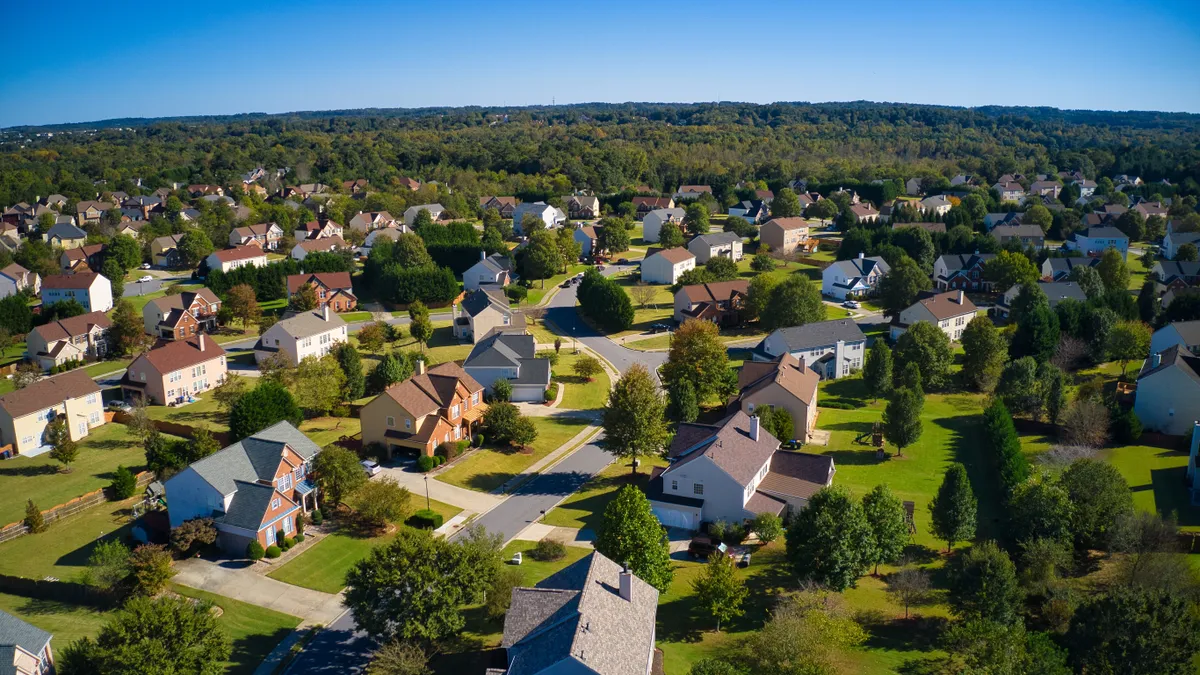City councilors in Shawnee, Kansas, in the Kansas City metro area, voted unanimously last month to ban "co-living groups," housing situations in which four or more unrelated adults live in a single housekeeping unit.
The move by the Shawnee council is far from unique. Municipal zoning regulations that restrict the number of unrelated adults living in a single unit are common across the U.S. The vote was in response to "a relatively new trend" of single-family homes being purchased and converted into rental units with multiple individual tenants, city council documents state. The Kansas City Star reported that the regulations were in response to a company called HomeRoom — which matches roommates and manages shared living spaces such as group homes — moving into the area.
Like much of the U.S., the city has become increasingly unaffordable, residents say, with wages not keeping up with the rising cost of buying or renting. Meanwhile, the nationwide housing crisis is largely attributed to a lack of housing inventory needed to accommodate population growth.
Both renting and buying a home in Shawnee's Johnson County is challenging, said Kristy Baughman, director of education and planning at the advocacy nonprofit United Community Services of Johnson County. In 2018, about half of all renters in Shawnee — which has a population of nearly 66,000 — were rent-burdened, meaning they pay more than 30% of their income for housing, according to a report from the nonprofit.
The co-living model is an opportunity that cities should explore, according to Baughman, and it could be used more broadly than many realize in the county. “I’ve spoken to a number of seniors, especially women who are on their own, on a fixed income and really struggling today in this current housing situation," she said. "I see a co-living situation really benefiting seniors."
In the long run, Shawnee's co-living ban will likely have a "have a modest impact" on housing affordability, said Katherine Levine Einstein, an associate professor of political science at Boston University and co-author of the book "Neighborhood Defenders: Participatory Politics and America's Housing Crisis."
But restrictive local policies, like the one in Shawnee, are criticized by housing experts and some community advocates for blocking the development of housing, particularly new affordable housing options. Local boards are influenced by vocal members of the community — often referred to as NIMBYs, for "not in my backyard" — who show up to meetings in opposition to new construction or zoning that would allow more housing density.
Federal and state efforts to expand housing options
As the housing crisis continues to worsen, there have been efforts at the federal, state and local levels to curb restrictive zoning and land-use policies. President Joe Biden recently introduced a plan to give cities and towns with reformed zoning and land-use policies higher scores for certain transportation grant opportunities through the bipartisan infrastructure law.
In Massachusetts, Gov. Charlie Baker, R, signed legislation last year that provided funds for new housing and made it easier for cities and towns to adopt "zoning best practices related to housing production." The new rule followed efforts from a long line of former Massachusetts governors who have tried to address housing affordability in the Bay State, including now-U.S. Sen. Mitt Romney, R-Utah, who signed a law as governor in 2004 providing financial incentives to cities and towns that created zoning for new rental and condo units next to rail stations, according to CommonWealth.
Last year, California Gov. Gavin Newsom, D, signed a law banning zoning restrictions that only allow single-family housing. Oregon Gov. Kate Brown, D, also signed a law in 2019 banning most single-family zoning while Minneapolis became the first large U.S. city to ban single-family zoning.
Rolling back single-family housing will not solve the housing crisis on its own, though. It needs to be part of a broader suite of changes that eliminate other restrictions such as setback and building height requirements and parking limits, Einstein said.
But recent efforts — such as those by Washington Gov. Jay Inslee, D, to lift zoning restrictions on the construction of non-single family housing such as duplexes, townhomes and courtyard apartments — have received pushback from cities concerned about losing local authority. In Massachusetts, leaders from some affluent communities, such as the town of Concord, have openly discussed ignoring the new law and risk missing out on state grants attached to it.
Marybeth Shinn, a Vanderbilt University professor focused on homelessness policies, said in an email interview that she has concerns similar to those raised by the Shawnee city council about corporate landlords buying up housing and turning it into unaffordable rentals. If the corporation has no roots in the community, and the profits they earn go elsewhere, communities can stand to lose, according to Shinn. Instead, she would rather see "Ma and Pa" landlords and homegrown options.
People need a place to live, Shinn said. "Making housing unaffordable by banning shared housing will force some people into homelessness."
Sharing costs with roommates, she added, is a way for renters to manage high housing costs. "Banning that practice will make it even harder for low-wage workers, young workers starting out and young families to manage," she said.
Opposition to new housing is 'a time-honored tradition'
Cities should encourage the development of affordable housing with zoning and incentives to developers and allow multifamily housing anywhere possible, especially near jobs and public transit, according to Shinn. Shared equity housing is also an option, she said.
But opposition to new housing "is everywhere," Einstein said, while data suggests that the opposition largely stems from majority-homeowner, White and older communities. People who speak at meetings often oppose the rapid change that new developments bring to their community and express a fear that the value of their home will be decreased, she said. That opposition also sometimes is rooted in racism and classism, she said.
Opposition to new developments cut across partisan lines as well, with some of the most intense pushback coming from San Francisco and other liberal California cities as well as more conservative and racially homogenous suburbs, said Martha Galvez, executive director of New York University's Housing Solutions Lab, in an email interview.
Race has been a "backdrop of zoning," Shinn said. She pointed to federal and local policies that historically have promoted racial segregation, including racial redlining, in which the Federal Housing Administration and other entities refused to insure mortgages in or near Black neighborhoods.
Opposition to new construction, particularly multifamily housing, subsidized affordable housing and rental housing in general, is "a time-honored tradition in many single-family suburbs" and existing land-use restrictions are rooted "in a long history of racial exclusion," Galvez added.
"People who are fortunate enough to have nice homes want to preserve their privilege, under the guise of 'the character of the neighborhood,'" Shinn said, "but that means keeping out poorer neighbors who are often members of racial minorities."
Wealthier communities in particular are able to effectively oppose new developments, according to Galvez. They are more politically powerful and have resources such as jobs and domestic help that allow them to participate in community meetings regardless of when they're scheduled, and they have the financial and legal resources to mount lawsuits, she said.
But recently, renters and tenant advocates have also opposed new construction, fearing gentrification and displacement, Galvez said. Research shows that new construction reduces pressure on rents and eases displacement, she said, but the long history of disinvestment and urban renewal in those communities gives residents legitimate reasons to be skeptical. Repairing that damage and earning that trust is an important aspect of implementing policies that can relieve housing shortages, Galvez noted.
"Regardless of where or why opposition to building housing happens, there’s a fundamental human aversion to change at play — most people like their neighborhoods, and want them to stay the same," she said.



















